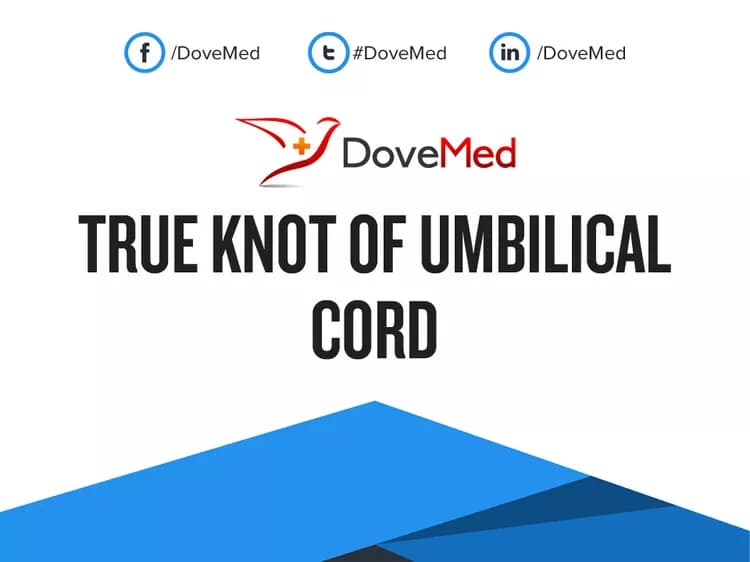What are the other Names for this Condition? (Also known as/Synonyms)
- Cord Knots in Pregnancy
- Placental Knot
- Umbilical Cord Knots
What is True Knot of Umbilical Cord? (Definition/Background Information)
- The placenta is an organ that connects the developing fetus to the uterine wall. It is a disc shaped reddish brown structure that connects the fetus to the mother through the umbilical cord. The umbilical cord contains two umbilical arteries and one umbilical vein
- The normal function of placenta is to supply nutrients and oxygen to the fetus from the mother’s blood and remove wastes from the fetal body
- An umbilical cord contains a special substance called Wharton’s jelly, which protects the umbilical cord vessels from damage and act as a cushion for them. A True Knot of Umbilical Cord is a knot in the baby’s umbilical cord
- The most common symptom of a True Knot of Umbilical Cord is decreased fetal activity after 37 weeks. Though, it is not associated with an increased risk of fetal death, occasionally complications can occur during labor and delivery
- With proper ante-natal care and appropriate management during delivery, the associated prognosis is very good
Who gets True Knot of Umbilical Cord? (Age and Sex Distribution)
- A True Knot of Umbilical Cord can occur in approximately 0.3% to 2% of all births
- A higher prevalence of the condition is observed in male babies than female babies
- There is no distinct racial, ethnic or geographical predilection observed
What are the Risk Factors for True Knot of Umbilical Cord? (Predisposing Factors)
Risk factors associated with True Knots of Umbilical Cord include:
- Multiple pregnancy including twins
- Babies with a long umbilical cord
- Small babies
- Too much amniotic fluid in the womb
It is important to note that having a risk factor does not mean that one will get the condition. A risk factor increases ones chances of getting a condition compared to an individual without the risk factors. Some risk factors are more important than others.
Also, not having a risk factor does not mean that an individual will not get the condition. It is always important to discuss the effect of risk factors with your healthcare provider.
What are the Causes of True Knot of Umbilical Cord? (Etiology)
- True Knots of Umbilical Cord mostly form early in the pregnancy because of the presence of more amniotic fluid and greater fetal movements
- They usually form when the baby moves around the cord, while being active in the uterus
What are the Signs and Symptoms of True Knot of Umbilical Cord?
A decreased fetal activity may be observed with True Knot of Umbilical Cord after the 37th week.
How is True Knot of Umbilical Cord Diagnosed?
The diagnosis of True Knots of Umbilical Cord may include:
- Routine ultrasound examination of the abdomen of the pregnant woman
- Color Doppler ultrasonography
- Examination of the placenta and umbilical cord at the time of delivery
What are the possible Complications of True Knot of Umbilical Cord?
Complications due to True Knot of Umbilical Cord could include:
- Worrying changes in the heart rate of the fetus
- Fetal death and stillbirths
How is True Knot of Umbilical Cord Treated?
True Knots of Umbilical Cord do not require specific treatment.
- In a majority of the cases, there are no complications. But, if the knot gets tight while the baby is passing through the birth canal, fetal death might occur
- Cesarean section can be done in cases of fetal compromise. In fetal compromise, the oxygen and nutrition supply is disrupted enough to affect the well-being of the unborn child
How can True Knot of Umbilical Cord be Prevented?
- Currently, there are no methods available to prevent a True Knot of Umbilical Cord
- Proper ante-natal care is essential to ensure a healthy pregnancy and uncomplicated delivery
What is the Prognosis of True Knot of Umbilical Cord? (Outcomes/Resolutions)
- The prognosis of True Knot of Umbilical Cord is excellent with suitable care and management during delivery
- The perinatal mortality of pregnancies with the condition is approximately 10%
Additional and Relevant Useful Information for True Knot of Umbilical Cord:
One should distinguish True Knot of Umbilical Cord from a false knot of umbilical cord; true knots are significant, whereas false knots are not. In a false knot, there is excess covering of the umbilical cord (Wharton’s jelly), which on appearance, resembles a true knot.
Related Articles
Test Your Knowledge
Asked by users
Related Centers
Related Specialties
Related Physicians
Related Procedures
Related Resources
Join DoveHubs
and connect with fellow professionals


0 Comments
Please log in to post a comment.